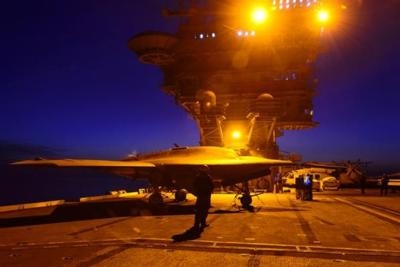Fri, Aug 29, 2014
Tests Included Five Cat Shots, Four Traps
The Navy's X-47B completed its final test aboard USS Theodore Roosevelt (CVN 71) Aug. 24 and returned to its home base at Naval Air Station Patuxent River after eight days at sea.

While underway, the X-47B flew in the carrier pattern with manned aircraft for the first time and conducted a total of five catapult launches, four arrestments and nine touch-and-go landings, including a night time shipboard flight deck handling evaluation.
Testing began Aug. 17 when the X-47B performed its initial cooperative launch and recovery cycle with an F/A-18 . With its automatic wing-fold capability and new tailhook retract system, the X-47B met the program’s objective to demonstrate that carrier-based manned and unmanned aircraft could maintain a 90 second aircraft launch and recovery interval.
Throughout the week, the Navy/Northrop Grumman test team captured X-47B flying quality and recovery wind condition data to evaluate how the aircraft responds to wake turbulence during approach and landing. This data will be used to improve a simulation model for use with carrier-based aircraft.
The team also evaluated how the unmanned aircraft performed during the first night time taxi and deck handling operations aboard a carrier. Since the shipboard environment presents different challenges at night, this test was an incremental step in developing the operational concept for more routine unmanned air system flight activity .
“We conducted X-47B night flight deck operations to understand the human interface and suitability of the unmanned air vehicle and deck operator’s hand-held control unit in the night environment,” said Barbara Weathers, X-47B Unmanned Combat Air System lead. “These lessons learned will help with the development of future unmanned platforms.”
The Navy will continue to execute shore-based testing at Patuxent River to further the goal of seamless integration with manned aircraft and to refine best practices for the evaluation of future unmanned air systems.
(Image provided by NAVAIR)
More News
He Attempted To Restart The Engine Three Times. On The Third Restart Attempt, He Noticed That Flames Were Coming Out From The Right Wing Near The Fuel Cap Analysis: The pilot repor>[...]
Make Sure You NEVER Miss A New Story From Aero-News Network Do you ever feel like you never see posts from a certain person or page on Facebook or Instagram? Here’s how you c>[...]
From 2009 (YouTube Edition): Leading Air Show Performers Give Their Best Advice for Newcomers On December 6th through December 9th, the Paris Las Vegas Hotel hosted over 1,500 air >[...]
Aero Linx: NASA ASRS ASRS captures confidential reports, analyzes the resulting aviation safety data, and disseminates vital information to the aviation community. The ASRS is an i>[...]
“For our inaugural Pylon Racing Seminar in Roswell, we were thrilled to certify 60 pilots across our six closed-course pylon race classes. Not only did this year’s PRS >[...]
 NTSB Final Report: Rutan Long-EZ
NTSB Final Report: Rutan Long-EZ ANN FAQ: Turn On Post Notifications
ANN FAQ: Turn On Post Notifications Classic Aero-TV: ICAS Perspectives - Advice for New Air Show Performers
Classic Aero-TV: ICAS Perspectives - Advice for New Air Show Performers ANN's Daily Aero-Linx (06.28.25)
ANN's Daily Aero-Linx (06.28.25) Aero-News: Quote of the Day (06.28.25)
Aero-News: Quote of the Day (06.28.25)



